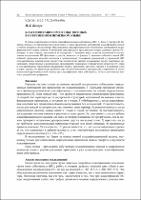Показать сокращенную информацию
Классификация имен собственных в современном немецком языке
| dc.contributor.author | Белоус, И. Л. | |
| dc.date.accessioned | 2020-09-25T11:27:05Z | |
| dc.date.available | 2020-09-25T11:27:05Z | |
| dc.date.issued | 2014 | |
| dc.identifier.citation | Белоус, И. Л. Классификация имен собственных в современном немецком языке / И. Л. Белоус // Веснік Брэсцкага універсітэта. Серыя 3. Філалогія. Педагогіка. Псіхалогія. – 2014. – № 1. – С. 52–57. | ru_RU |
| dc.identifier.issn | 2218-029X | |
| dc.identifier.uri | https://rep.brsu.by:443/handle/123456789/1629 | |
| dc.description | The article envisages the classifications of proper names (PN) made by the researchers A. Bakh, G. Bauer and V. Kamenets, their advantages and disadvantages are described, as well as our own onyms’ division is offered in accordance with the research material. The proposed proper names’ classification is based on the onyms’ referential theory. In the author’s classification there have been presented four main groups of proper names, which in turn are divided into subgroups: 1) the names of living beings (individual and collective anthroponyms, proper names of fictitious beings, animals and flora); 2) the names of events and things (the proper names of events, natural phenomena, ideonyms and сhrematonyms); 3) the names of organizations and institutions (the proper names of public, commercial institutions, political parties, music groups, sports organizations, public and religious organizations); 4) the names of geographical objects (proper names of countries and government entities, federal lands, provinces, cantons, cities and districts, streets and roads, buildings, geographical regions, mountains, objects of extraterrestrial space, hydronyms). In the article the functional approach is used while the proper names’ classifying, that is taking into account the context of referent usage. | ru_RU |
| dc.description.abstract | В статье подробно рассмотрены классификации имен собственных (ИС) А. Баха, Г. Бауэра и В. Камянца, описаны их преимущества и недостатки, а также предложена собственная классификация онимов с учетом материала исследования. Предложенная классификация имен собственных основывается на референционной теории онимов. В авторской классификации представлены четыре основные группы ИС, которые, в свою очередь, разделяются на подгруппы: 1) названия живых существ (единичные и коллективные антропонимы, ИС фиктивных существ, животных и флоры); 2) названия событий и вещей (ИС событий, природных явлений, идеонимы и хрематонимы); 3) названия организаций и учреждений (ИС государственных, коммерческих институтов, политических партий, музыкальных групп, спортивных организаций, общественных и религиозных организаций); 4) названия географических объектов (ИС стран и государственных образований, федеральных земель, провинций, кантонов, городов и их районов, улиц и дорог, зданий, географических регионов, гор, объектов внеземного пространства, гидронимы). В статье использован функциональный подход при классификации имен собственных, то есть учитывается контекст употребления референта. | ru_RU |
| dc.language.iso | ru | ru_RU |
| dc.publisher | БрГУ имени А.С. Пушкина | ru_RU |
| dc.relation.ispartofseries | Серыя 3. Філалогія. Педагогіка. Псіхалогія; | |
| dc.title | Классификация имен собственных в современном немецком языке | ru_RU |
| dc.title.alternative | Proper Names’ Classification in Modern German | ru_RU |
| dc.type | Article | ru_RU |
